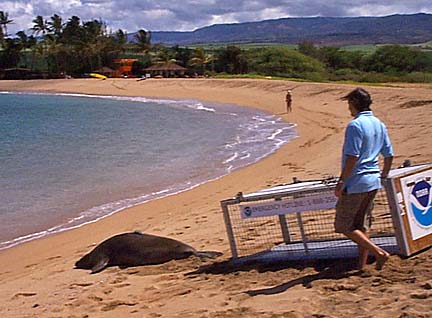
Independence Day was two days late for TT40, who was released from captivity yesterday morning at Salt Ponds Beach on Kauai's west shore. TT40 had a fish hook removed from his esophagus during a rare operation.
Healthy monk seal
released on KauaiMarine biologists will track
the animal's actions to monitor
any behavioral changes
LIHUE >> State marine biologist Don Heacock said he saw a smile on Hawaiian monk seal TT40 after the animal was returned to the ocean at Salt Ponds Beach on Kauai after nearly a month of emergency medical care.
Biologists from the National Oceanic and Atmospheric Administration and Coast Guard air crew members, who came down to the west Kauai beach to help unload TT40, were all smiles themselves yesterday.
Following a dramatic rescue, a flight to Oahu, and surgery to remove a fishhook lodged in his esophagus, TT40 was flown back to Kauai early yesterday and turned loose inside the reef. He carefully checked out the cove in which he had been set free, and then disappeared out to sea.
Heacock said it appears that the incident in which TT40 swallowed a large fishhook was an accident. Most fishermen will reel in their lines when they spot a seal, but TT40 was hooked by fishermen fishing at night for ulua.
"They didn't even see the seal," Heacock said.
TT40, a 20-year-old male weighing about 450 pounds, seen regularly around Kauai for the past several years, had been captured in Poipu on Feb. 18 and a satellite tag was placed on his back.
On June 4, he was seen near the Kilauea Lighthouse with a fishing line dangling from his mouth. The satellite tracker allowed biologists to track him. He was spotted on June 7 at Kappa, June 9 at Poipu, and finally at Waimea on June 10. The next day he was flown to Oahu by a coast Guard C-130.
Dr. Bob Braun, a contract NOAA veterinarian who estimates he has treated between 400 and 500 monk seals over 10 years, located the hook lodged in the esophagus near the seal's heart.
He decided it could only be removed by a type of surgery -- called a gastrotomy -- performed successfully only once before on a Hawaiian monk seal.
Charles Littnan, a NOAA ecologist, is responsible for tracking the seals fitted with satellite tags. The tags not only transmit the seal's position but send data on the depth and duration of their dives.
"Because we already have data on TT40's normal behavior prior to ingesting the hook, we plan to closely monitor his behavior now to see if it has changed," Littnan said.
The tag should keep transmitting for about five more months. People interesting in watching TT40's travels can see the tracking data from the seal on a NOAA Web site: www. pifsc.noaa.gov/pifsc_hot.html
NOAA Office of Protected Resources
www.nmfs.noaa.gov/prot_res
